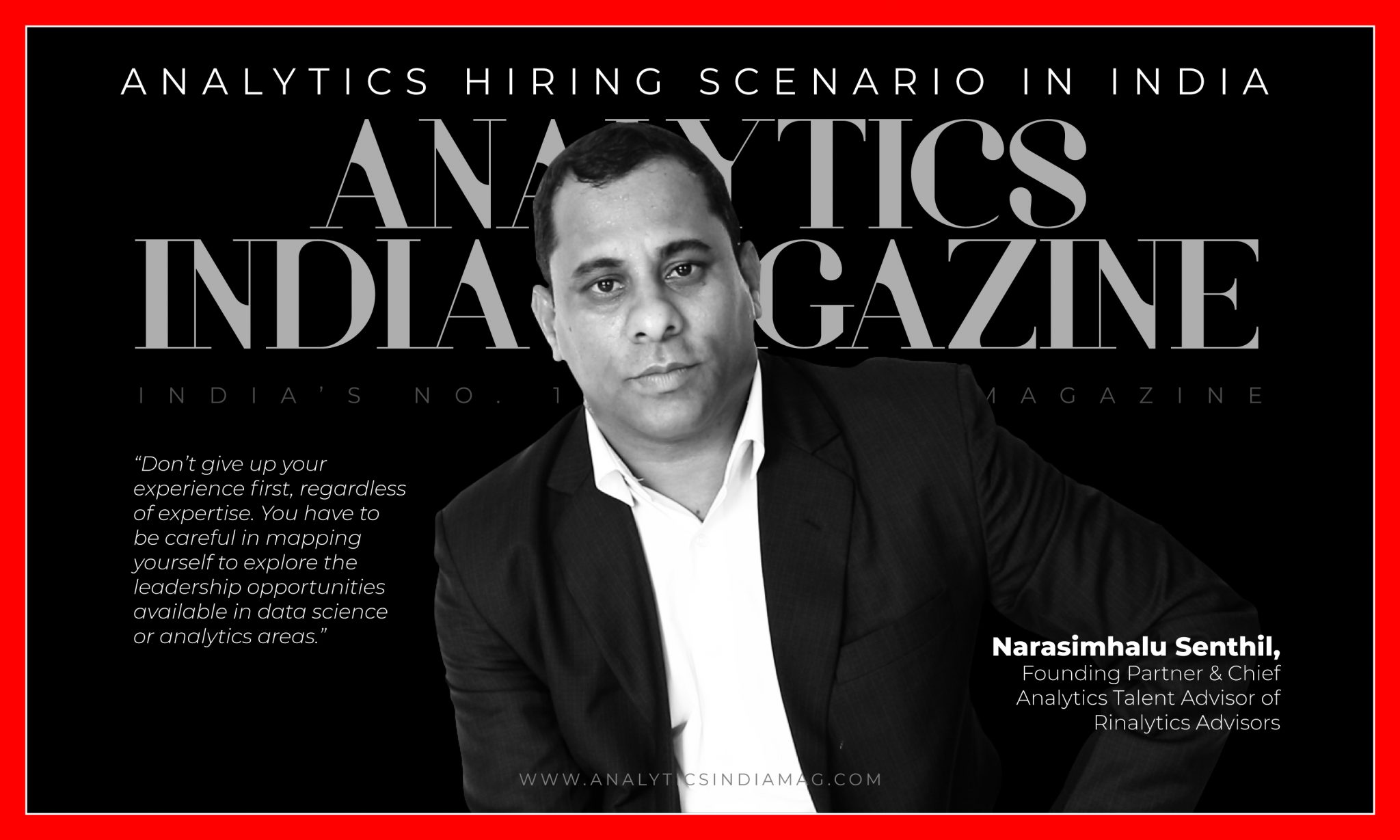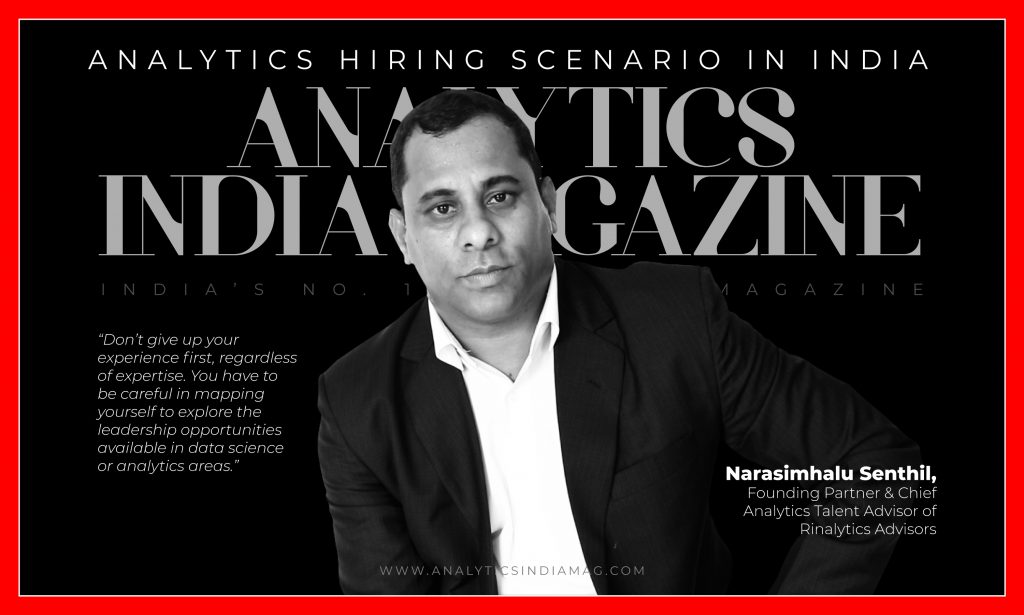Analytics India Magazine spoke to Narasimhalu Senthil, founding partner and chief analytics talent advisor of Rinalytics Advisors about the rise of this sector, and the challenges regarding the talent pool.
Senthil, a veteran in this area, has worked extensively in consulting and has served clients across Europe. Senthil is an MBA and has over 15 years of work experience with over nine years in the recruiting area.
Senthil spoke to AIM about how analytics has risen over the years, its key skill sets and how it has impacted leadership roles at various business sectors.
Here are the excerpts from the interview:
Analytics India Magazine: How many data scientists do you think are there in India?
Narasimhalu Senthil: Every year India is producing more than five lakh data scientists. It’s a combination of business analysts moving into data science role. But the area of data science is bifurcated into the core areas like machine learning, deep learning and NLP. If you consider this definition, then it is more than one lakh in India.
AIM: Is ‘Data Scientist’ the sexiest job of the 21st century?
NS: I would say, it’s more of a style statement. According to me, it is a role, it is an important position in any organisation across the industry sectors, where businesses are generating enormous amounts of data. Obviously, the position of data scientist is of utmost importance and plays a critical role in businesses.
AIM: There is a lot of buzz about analytics, big data and AI around the industry. Do you think these are mere buzzwords or are we actually seeing an analytics revolution in IT?
NS: The industry has seen a lot of return on investment (ROI) coming from the implementation of AI capabilities. It is not a myth, it is the reality. Many big companies like Black & Decker, have already demonstrated a huge ROI on the AI investments they made earlier. Like this, right from a consumer internet business to a large manufacturing or industrial companies, analytics capabilities have been improved vastly.
AIM: Do you think Data Scientists are expensive and hard to find?
NS: It is indeed hard to find. It depends on how we define ‘data scientist’ since we are a leadership hiring firm. The true meaning of data science from our client perspective is centrally different from the majority of talent we see in the industry. Let’s say, someone who writes a simple regression algorithm, you cannot simply call the person a ‘data scientist’. Data scientists need mature business thinking, problem-solving thinking and programming skills.
Someone who can solve the business skills through data science is a data scientist, and if you go as per this definition, it is certainly hard to find and they are expensive
AIM: How does the analytics leadership hiring scenario in Indian companies look like?
NS:Even at a leadership level, a strong career transition is happening. Junior to mid-level employees are trying to shift their career in analytics. The trend is the same at the leadership level, but at this level, it is much more strategic and thoughtfully done.
For example, most of the Indian business houses are conglomerates if you look at. Every business is going through digital transformation programs. They are not hiring chief technology officers externally. According to us, the trend has been that the companies’ chief information officer, group CTO or group CIO becomes the CTO. In this aspect, ‘digital’ means, it is the combination of technology, automation, data science and analytics. So it is easy to transition from group CIO to a CTO.
Large Indian business houses are taking this route. Generally, at a leadership level, I would say it is good to take a transition within the company instead of trying to jump and seek transition from one company to other. Therefore, leadership hiring has been good and has seen a surge of 20 percent in analytics and AI areas. Unfortunately, companies have been choosy in picking up their leaders. They are very particular right from domain expertise to the core fundamentals of math & stat backgrounds they come from. However, there is a huge demand for analytics leaders across various industry sectors.
A lot of traditional industries such as manufacturing and automotive industry are setting up their own R&D digital arms. So everyone is looking out for talent. While there is 30-40 percent transition happening within the group but the remaining 50-60 percent is more of external hires.
AIM: Do you think there is an imbalance between the available talent and required skill set in the analytics industry?
NS:Certainly yes. Recently, I read a report published by one of the large research firms. There is a demand for data scientists in excess of 400 percent, but the supply is only 19 percent. If you look at it, only 5 percent of the talent is being supplied and the industry needs much more. The reason being, a certain gap in terms of skill sets which organisations are looking at, and what a typical data scientist brings in.
In our experience, one of the most important gaps we have seen is, although today’s models or algorithms play a critical role, but fundamentals of statistics and maths have been missed out in a larger sense. Organisations are becoming much more sensible to understand how fundamentally the individual is strong. So, while picking up a course, taking up some tools, training etc. does help understand from a high-level perspective, companies who strive to solve a deep problem see that the person is from a statistics and math background.
Unfortunately, math and statistics have been given less importance in school. Everyone wants to pursue computer science etc, but they all realise that math plays an important role. That is definitely a gap we see across various levels in the industry.
The larger portion of scenarios which we have seen, data scientist lose business needs in the problems and also approaches that we have missed out. But, today when tech companies are hiring, captive centres and analytics centres of excellence(CoEs) are trying to evaluate the consulting skills. Therefore, few of our largest financial captives see data scientist bringing consulting because it becomes easy to convert business problems for data science. So, these gaps will be there but it may change in the coming days.
AIM: Is analytics talent appreciated more than other talents in the tech industry?
NS: Certainly. If you come in a combination of tech and analytics, you are well-appreciated than only with analytics. So, the technocrats moving to the data science space are much more in demand and appreciated than a standalone stat/math person who only builds algorithms. But at the same time even if you come from a non-tech background i.e, pure-play analytics background, it is good. It also depends on your background and business scenario experience.
The best combination could be tech and domain experience, the domain he/she belongs to & analytics experience, if you have these three in a combination, prospects would have much more job-opportunities in the market.
AIM: What are the skill sets that companies look at while looking for leadership candidates in analytics?
NS: The leadership role is basically the ability to transition the whole legacy systems into digital transformation programs. It is to think from a holistic perspective of the business which is not necessarily analytics alone. Even the analytics leader is being asked to think from a technology perspective. The ability to marry an integrated approach within the businesses which is technology, automation or AI products, it becomes very important when you are hiring leadership talent right.
It also depends on the scenarios, product firms need different leaders, consulting teams need different leaders because they need more business skills and product-related thinking. If you look at conglomerates like Tata or Aditya Birla, it is a multi-industry experience than a single industry focussed domain.
From a skills perspective, if you think from a larger industry-wide problem to solve than looking at problems dedicated to that particular business. Most importantly, from a leadership perspective, we advise the leaders to take a multi-industry view of the analytics landscape than tying themselves to one industry. Our clients do not want to hire the analytics talent from the same industry, they wanted to have a cross-industry experience being leveraged to their businesses.
AIM: What are the various initiatives that companies and educational institutions can take to set right the analytics talent flow?
NS: From a company’s perspective, a lot of companies have set up their own innovation hubs. Not just tech R&D or product environment-oriented companies come up with this, there are services companies like Infosys and HCL that have set up ‘innovation labs’ to meet their customer needs from a data science skills perspective.
While the collaboration with institutes or university programs help to some extent, most of the companies prefer their own captive innovation route than on external collaboration or partnership on the skill enhancement programs. In terms of academics, I think government has stepped up extremely well on data science. NITI Aayog is doing extremely well in terms of setting up policies for data science, and also how talent pool can be enhanced.
A lot of corporates have also tied up with universities and designed the curriculum in a way that when fresh graduates come out of college they are deployed into a project. But, still we are at the earlier stage. Maybe it might change in a couple of years.
AIM: What are the three skills that you look for while hiring a candidate?
NS: Scientific thought leadership — someone who can think through the problem rather than solving, a very strong business consulting experience and problem-solving skills
AIM: What is your advice to experienced professionals who are now looking to transition into analytics?
NS: Don’t give up your experience first, regardless of expertise. You have to be careful in mapping yourself to explore the leadership opportunities available in data science or analytics areas. Many times people tend to give up their experience they bring in and restart their career themselves. Please do not do it. Map your skill. Map your domain experience and see for these two criteria to tag opportunities. We have seen 80 percent of leadership talent have given up their experience just to jump to data science.
Another point is when you try to transition to a leadership level, it’s very often suggested that to do it internally within the company than exploring outside and trying to prove your mettle there.



















































































